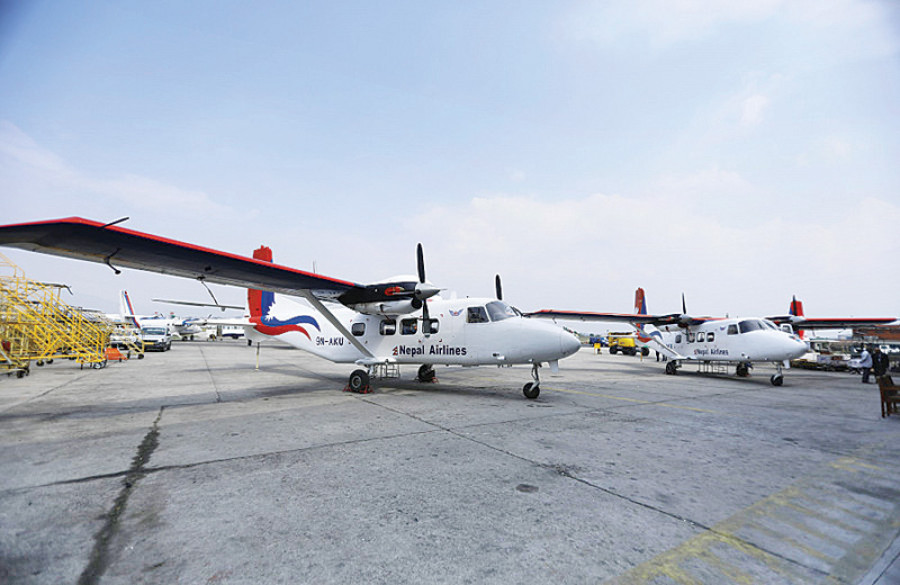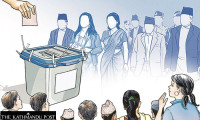National
Fed up of losses, Nepal Airlines comes up with options to get rid of six Chinese aircraft
Grounded due to technical issues and lack of manpower and spares, they have made losses of over Rs2 billion, the state-owned carrier said.
Sangam Prasain
Nepal Airlines has submitted four options to the Ministry of Tourism to get rid of the six inefficient Chinese aircraft in its fleet, five months after its board of directors unanimously decided to stop flying them as they were worsening its losses.
At least two tourism ministry officials contacted by the Post said they had received the proposal from the state-owned carrier, and were studying the alternatives.
Nepal Airlines has repeatedly said that the Chinese-made planes were causing heavy losses ever since they were acquired between 2014 and 2018, and that it wants to remove them and stop further losses.
The first option, according to an unnamed ministry official, is to ask the aircraft manufacturers to buy back the planes by evaluating their existing worthiness.
In November 2012, Nepal Airlines signed a commercial agreement with Aviation Industry Corporation of China (AVIC), a Chinese government undertaking, to procure six aircraft—two 56-seater MA60s and four 17-seater Y12es.
As part of the deal, China provided one MA60 and one Y12e worth Rs2.94 billion as gifts in 2014. The other aircraft were bought for Rs3.72 billion with a soft loan provided by China’s EXIM Bank.
The 17-seater Y12e is a twin-engine turboprop utility aircraft built by Harbin Aircraft Industry Group, previously Harbin Aircraft Manufacturing Corporation. The 56-seater MA60 is a turboprop-powered airliner produced by China's Xi'an Aircraft Industrial Corporation. Both manufacturers are subsidiaries of AVIC.
The second option presented by the flag carrier is to lease the planes to interested Nepali operators on either a long-term or a short-term basis.
The third alternative is to auction off the planes.
The fourth option is to look for Chinese or international companies or banks interested in buying or leasing them.
“Nepal Airlines has been planning to buy other planes like the Twin Otter by selling the Chinese-built planes,” the ministry official said. “However, there isn’t an option presented that if the Chinese companies can assure regular maintenance or provide spare parts, the planes can fly smoothly. It’s clear that Nepal Airlines doesn’t want to fly the Chinese planes anymore.”
The flag carrier has already bid adieu to its pilots hired to fly the Chinese planes.
Buddhi Sagar Lamichhane, joint secretary of the Tourism Ministry who looks after aviation affairs, said that discussions would be held with the Finance and Foreign ministries to sort out the issue.
While Nepal Airlines is the operator of the planes, the Tourism Ministry is the owner. The Finance Ministry is the financier of the Chinese planes. As China has given two of the planes as a gift, it’s difficult for the government to sell them.
“So, there is a need for extensive discussions with all the ministries to find a solution,” said Lamichhane.
In 2014, marking the beginning of what was supposed to be a new era for Nepal Airlines after acquiring the planes, it had even changed its classic red and blue stripes livery, opting for a more modern design.
In 2014, although one 17-seater Y12e aircraft and one 56-seater MA60 arrived in Kathmandu as a precursor to what the new era would be like, they never took to the air.
The delivery of the rest of the Chinese aircraft was stalled for years after issues appeared in the first batch of planes that arrived in 2014.
These issues included lack of pilots, lack of instructor pilots, lack of spare parts and lack of engineers trained to maintain them.
The second batch of MA60 and Y12e aircraft, as part of a six-aircraft deal between Nepal and China, arrived in January 2017.
The corporation received the final two Y12e aircraft in February 2018.
The initial issues were not fully resolved.
The corporation had raised four issues—aircraft performance, insurance premium, timely delivery of spare parts and cost of spare parts—as reasons it wants to dispose of the aircraft.
As per the November 2012 agreement, China had given a seven-year grace period under which Nepal Airlines would not have to repay the loan interest and instalment. The payback period of the loan is 20 years.
The Nepal government has to pay an annual interest rate of 1.5 percent and a service charge and management expenses amounting to 0.4 percent of the overall loan amount taken by the Ministry of Finance as per the deal.
The ministry, in turn, would charge Nepal Airlines an annual interest rate of 8 percent on the disbursed loan amount.
Nepal Airlines said that the Chinese planes had already caused losses of more than Rs2 billion as of the last fiscal year that ended mid-July, and that they were mounting each passing month.




 16.12°C Kathmandu
16.12°C Kathmandu















